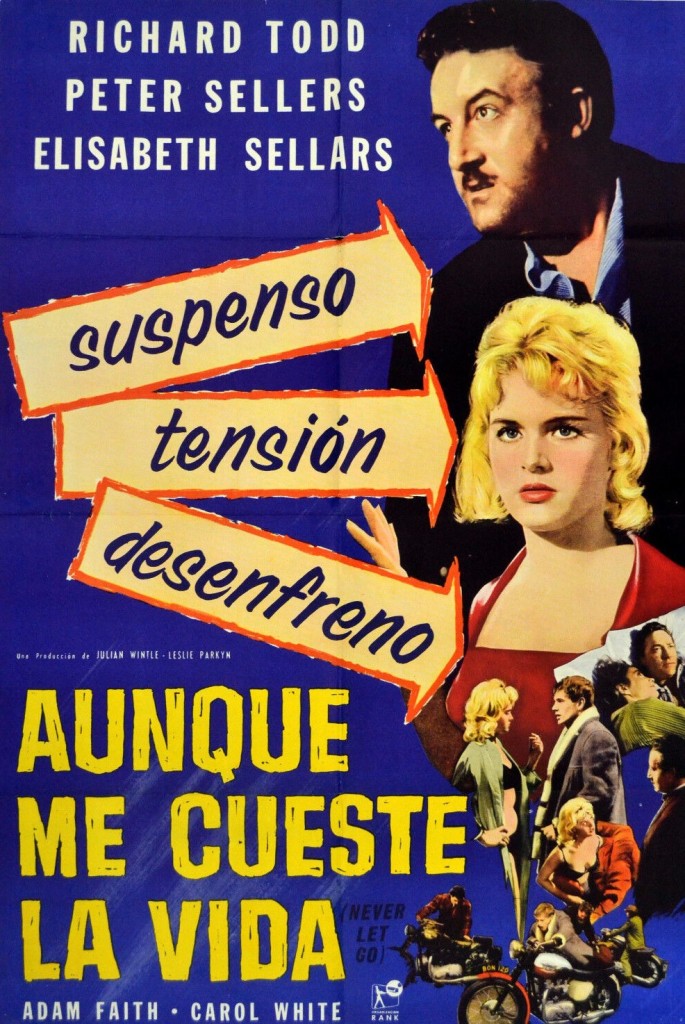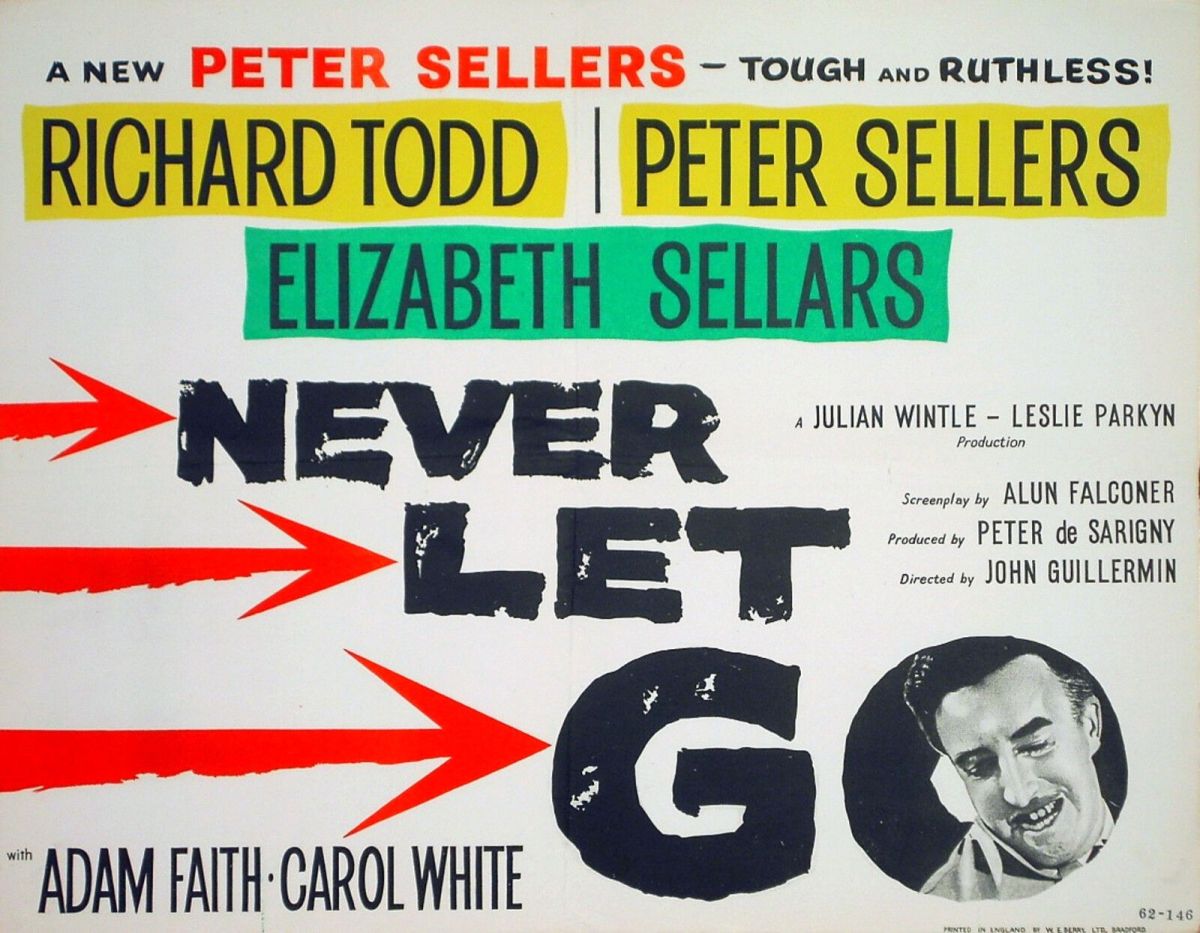Under-rated British film noir classic. All the principals playing against type. Comedian Peter Sellers (The Millionairess, 1960) as the villain, British hero Richard Todd (The Dam Busters, 1955) comes seriously unstuck, pop star Adam Faith (Beat Girl / Wild for Kicks, 1960) tosses away his cuddly image. One of the earliest scores by John (James Bond) Barry. First grown-up role for Carol White (Daddy’s Gone A-Hunting, 1969). As much savage violence as the censor would allow at the time.
Down-on-his-luck salesman John (Richard Todd) has his car stolen. It’s uninsured. Without it he can’t get to his appointments on time. The police aren’t interested. So he has to investigate. That leads first to dodgy Teddy Boy Tommy (Adam Faith) who steals cars to order for supposedly legitimate businessman Lionel (Peter Sellers) and makes a play for Lionel’s young mistress Jackie (Carol White).

The interest lies not so much in the investigation as how those involved deal with pressure. John, hardly able to support wife Anne (Elizabeth Sellars) and two kids, has a history of failure, squandering money on get-rich-quick schemes, and apt to blow his top at clients who complain when he fails to keep appointments.
Doesn’t take long for him to lose his job. But instead of knuckling down and finding another, he stubbornly refuses to abandon his investigation, upsetting Scotland Yard Inspector Thomas (Noel Willman) who has much bigger fish to fry.
Lionel is a cocky gangster not afraid to lash out. In fact, he seems to enjoy battering people with his fists, feet and broken bottle. He treats Jackie with contempt, reminding her she’d be a sex worker if it wasn’t for him. He’s got a nice little empire and has kept his nose clean. He pays off corrupt cops.
But the last thing he expects is to be pursued by a loser like John who’s not cut from the John Wick template. Not does he possess the very particular set of skills that appear to be the prerequisite of anyone embarking on a mission of revenge.

If director John Guillermin (El Condor, 1970) hadn’t been obliged to tag on a happy ending, this would have been a downbeat tour-de-force, with the good guy losing everything in order to win back his self-respect.
It just sizzles with tension. Lionel belongs to the generation that spawned the likes of Harold in The Long Good Friday (1980) or the Kray Twins, a simmering, stewing piece of work, all gloss on the outside, a tinderbox on the inside.
There’s fabulous photography, eyes trapped in pools of light, overhead camera staking out victims, and seedy London picked out in detail. Newspaper vendor Alfie (Mervyn Johns), of pensionable age, the only witness to the crime, has his bedsit ransacked, the tiny terrapin he treasures crushed underfoot, when inadvertently he gives too much away.
Tearaway Tommy isn’t such a tough guy when Lionel comes battering on his door. Jackie is the only one who not so much stands up to Lionel as treats his idea of romance with disdain. Even when John fingers Lionel, Inspector Thomas bluntly tells him he’s too small fry and the cops aren’t interesting in chasing after his plebeian vehicle.
Lionel is the kind of gangster who is never going to realise he can’t always get away with it, that he might have to trim back his ambition until the coast is clearer. Instead, he batters on regardless, determined to terrify everyone into acquiescence.
As the movie progresses, the more you learn about John, the less you sympathise. His wife has stood by him through mostly thin, and will stick by him even if unemployed, but draws the line at antagonising a gangster who doesn’t know when to draw a line. John isn’t Gary Cooper in High Noon. He’s not a principled defender of the law. He’s almost as bad as the gangster, in that he doesn’t know when to stop, regardless of the danger this places his family.
Understandably, Peter Sellers attracted most of the critical plaudits, but this is the role of a lifetime for Richard Todd, who detonates his screen image, battered and bloodied almost beyond recognition, not hiding behind a stiff upper lip. Carol White, too, is superb as the mistress who just about recognises that this is not a good deal, and that she’s a chattel, not a loved one.
John Guillermin’s direction is superb. Coupled with the insistent, jazzy John Barry score, this is British film noir (admittedly, that’s not large pool to draw on) at its best.

Thanks for picking out this title. It certainly sounds worth watching. The production company Independent Artists often made B crime films but their full length features, like this one, sometimes had good casts and creative input. Christopher Challis who began with The Archers is the cinematographer here. Adam Faith made several films around this time and was later well-known for the TV series Budgie. My only slight concern is your reference to this as a ‘British noir’. Firstly, I think the term is used far too loosely these days, especially by Americans. Secondly you suggest that there aren’t many British noirs. I would argue that in the period from the late 1940s to the early 1950s there are several excellent British films noirs which stand up to comparisons with US product. I think the more likely contemporary categorisation of this film would have been ‘crime melodrama’. Crime films were by far the largest category of British films during the 1950s into the early 1960s.
LikeLiked by 2 people
Appreciate your insightful comments. I plead guilty to the noir rap. I’m using shorthand – crime melodrama doesn’t cut it as well as noir. Minus the femme fatale – though White does unhinge Sellers – this has the b/w lighting and style of noir, But has more in common with Villain and Get Carter. Not sure, though, the best of British noir stands up to the best of American.
LikeLike
Re British Noir, I’m thinking of ‘He Made Me a Fugitive’ (Cavalcanti 1947), ‘Mine Own Executioner’ (1947) and ‘The Small Back Room’ (1949), ‘Obsession’ (Dmytrck 19490 and two Ealing noirs, ‘Frieda’ (1947) and ‘Cage of Gold’ (1950). There are interesting links between each of these films.
LikeLiked by 1 person
I’ve seen Small Back Room and Cage of Gold. Very fond of Simmons in The Clouded Yellow.
LikeLike
This does sound interesting, are you having a Carol White season is is this just a coincidence?
LikeLiked by 1 person
Purely coincidence. I’m sure I’ll get to her other pictures though.
LikeLiked by 1 person